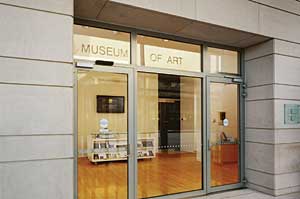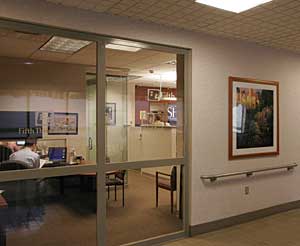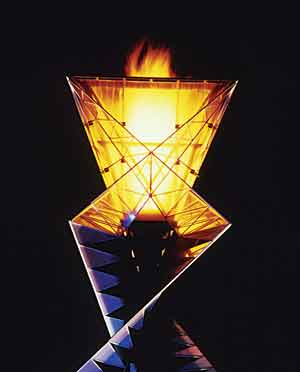Designing with Fire-Rated Glass: Integrating Life Safety, Transparency, and Aesthetics
Larger Size Glass
The vast majority of the newer wireless fire-rated glass products are listed with independent testing laboratories for use in larger sizes than polished wired glass. Larger sizes offer more flexibility for design concepts where ratings must be provided. The maximum dimensions for glass in fire doors and windows have been greatly increased.
For example, when wired glass is used in a 45-minute opening (a typical requirement in fire-rated corridors), codes have historically limited the size to 1,296 square inches (9 square feet), the maximum size successfully fire tested by Underwriters' Laboratories (UL), or other independent labs. Since wired glass was such a dominant product for years, many building codes established 1,296 square inches as the maximum allowable size for any type of fire-rated glass.
|
As new products became available, they were capable of exceeding the existing code limitations. Standards had to be rewritten accordingly. Today, depending on the product and application, a window requiring a 45-minute rated product may have a single piece of glass over 40 square feet. These increases in allowable glass size have given tremendous design flexibility to architects and designers, by minimizing the amount of required framing, while maximizing transparency and aesthetic appeal.
Overall allowable glass size in doors has also increased. In the past, a typical steel fire door with a 90-minute fire rating would often have used a 100-square-inch vision panel. Whether the door lite was 10-inch by 10-inch or a narrow 4-inch by 25-inch strip of wired glass, vision through the door was minimal. When combined with the industrial look of a steel fire door, the overall aesthetics were limited. Fire-rated ceramics have greatly increased the allowable glass size in steel or wood fire doors. Instead of 100 square inches, 90-minute steel doors may now incorporate ceramics exceeding 9 square feet per glass lite. For lower fire ratings, such as 45- or 60-minute doors, allowable glass sizes are even larger.
Increased allowable glass sizes provide architects with greater design flexibility. By using ceramics that allow larger sizes and wireless vision panels, doors, windows, and entryways can blend seamlessly with non-rated systems used throughout a building. However, with increases in glass sizes, other important aspects of fire-rated glass must also be considered, including the ability to withstand human impact and overall performance during a fire.
Impact Resistance
Fire is a major concern in all buildings. Yet in public facilities with high traffic volumes, injuries from glass breakage are often much more of a risk. Although wired glass offers excellent fire ratings, it cannot withstand much in terms of human impact. In fact, once broken, wired glass can be more dangerous than ordinary window glass, since the broken wires can create sharp snags.
For years, this posed a dilemma as to which need was more critical, since no glazing material could provide both fire and impact protection. The codes came down on the side of fire, determining that the threat of damage from fire was greater than the threat of injury from glass breakage. So in the 1970s, the Consumer Product Safety Commission (CPSC) granted a temporary exemption to wired glass, allowing its use despite its inability to earn high impact ratings. With limited options that could meet fire codes, there was little choice.
|
As time has gone by, the demand for safer facilities has continued to fuel increasingly stringent code requirements, making it more difficult to focus on a single safety need to the exclusion of another. Seeing the opportunity for innovation, manufacturers began developing products that could better serve dual roles of fire and impact protection.
As a result, most fire-rated glass products available today satisfy CPSC 16CFR1201 (Category II), the highest standard of impact safety for window glass. Whereas wired glass can only withstand approximately 100 foot-pounds (ft.-lbs) of impact, materials satisfying the Category II requirements are subjected to an impact approximating a full-grown adult running into the glass, or 400 ft.-lbs of impact. This means many of today's fire-rated glazing products exceed the safety impact resistance of traditional wired glass by four times, or more.
Performance improvement has led to increased impact safety. The newer fire-rated glazing materials surpass traditional wired glass in terms of fire safety as well. Some of the new glass ceramic products highlight this point. Ceramic materials are well known for being able to withstand heat. From cooktops to car engines, manufacturers have taken advantage of the fact that ceramic has a very low coefficient of expansion when heated. Fire-rated glass composed of transparent ceramic has been able to earn fire ratings as high as 3 hours, making it an outstanding thin and wireless alternative to wired glass. In fact, the use of ceramic to hold the flames in the 2002 Olympic Cauldron during the Winter Games in Salt Lake City shows that containing fire for days, rather than hours, is not a problem. Such performance is not possible with wired glass.
|
When determining allowable ratings of windows in a fire-rated corridor, design professionals often note that windows are required to provide 45 minutes of fire protection, when the corridor is rated for 1 hour. This condition relates to the historic performance limitations of wired glass. Like its size limitation of 9 square feet, the 45-minute rating was established because that was the longest duration wired glass could perform during a fire. Any longer, and the panel of wired glass would tend to slump from the opening, allowing passage of smoke and flames. As a result, building codes were developed in consideration of this performance limitation. While wired glass couldn't provide the optimal result by matching the 60-minute performance of the surrounding wall, some level of protection was considered to be better than none at all.
Transparent ceramics, however, have no such performance limitation and can provide a fire protection rating that matches the surrounding wall. By using ceramics, corridors rated for 60 minutes can now have openings that also provide a 60-minute rating. The weak link of allowing 45-minute windows in a 1-hour corridor is no longer necessary when architects and specifiers use ceramics that provide a full 60 minutes of fire protection.
Occasionally, the need for higher fire ratings is accompanied by the requirement to block the passage of heat, in addition to flames and smoke. Heat can build up quickly in stairwells and other areas where building occupants could become trapped for long periods of time. Extremely high temperatures transferring through the glass could be just as devastating as the fire itself. For this reason, certain types of fire-rated walls do not allow openings of any kind. For many years, this requirement put severe design limitations on architects who desired transparency in these areas. Be it a three-story exit stairwell or two-hour occupancy separation, solid cinder block or sheetrock walls were the primary means of meeting code requirements. With developments in fire-rated glass and framing, however, these design limitations no longer exist.
Glass fire walls (sometimes called transparent wall units) address this issue directly. They are composed of multiple layers of glass with a layer of an intumescent material in between, which turns to foam during a fire. Glass fire walls are tested to the same standards as barrier walls. This means that while allowing full vision for aesthetic and security reasons, they perform in a manner similar to cement block walls during a fire.
These products greatly reduce heat transfer and therefore can be used in applications where other types of fire-rated glass would not be sufficient. And because they're not considered an opening, glass fire walls allow an unlimited amount of glazing in a wall, making it possible to design with floor-to-ceiling glass, while maintaining a 2-hour fire rating. Full-lite doors can also be utilized within these transparent fire walls.












